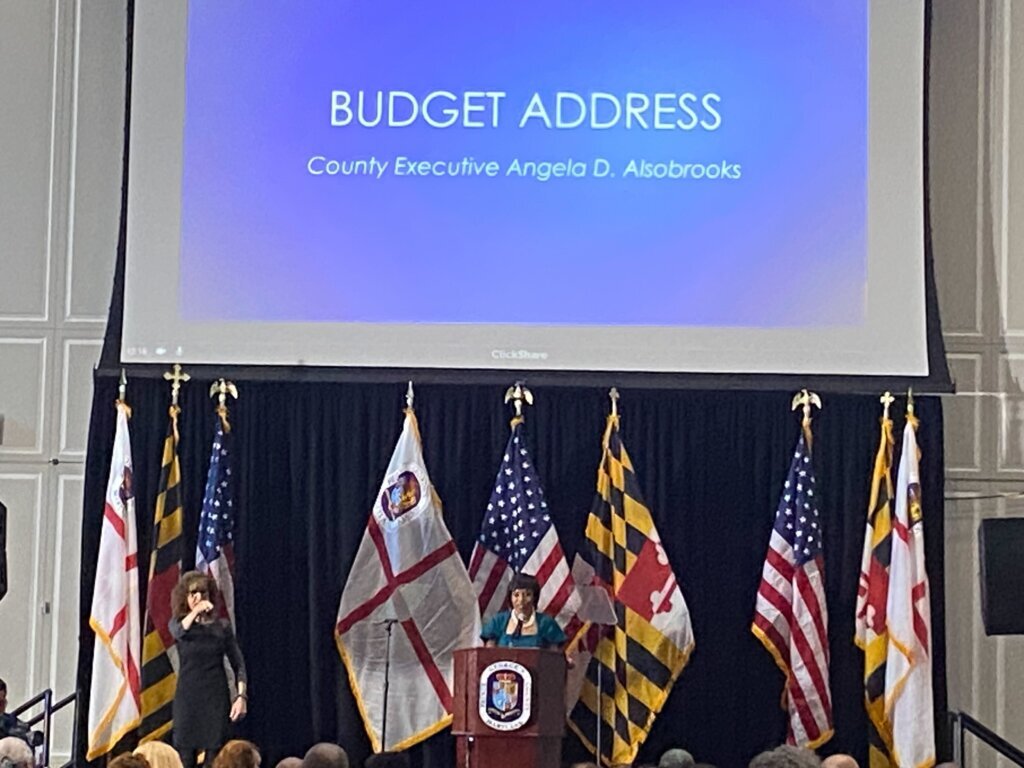Normally, budget proposals are a chance for elected leaders to highlight their goals and aspirations — put their money where their mouth is, so to speak — and they’re unveiled with lots of promises and optimism. But a lot of that was missing this year in Prince George’s County, Maryland.
With 82% of the county’s budget being devoted to education and public safety, most of the $5.4 billion budget was accounted for quickly before County Executive Angela Alsobrooks even got a chance to think about new priorities. And as of late, Alsobrooks hasn’t been shy about blaming state lawmakers in Annapolis for that bind.
“As a result of the legal mandate that we have, we’re required to give 62% of our budget to our school system,” Alsobrooks said. “The legally mandated funding requirements charge communities with more vulnerable children, like ours, extra.”

This year, the county is spending more than $88 million on education, more than the entire Department of Health and Human Services, and more than half of the new revenue being generated in the county.
After her speech, delivered at the University of Maryland, Alsobrooks explained why she was lobbying lawmakers in Annapolis to change the formula that determines funding requirements for what’s formally known as “The Blueprint for Education,” which is often referred to as the Kirwan Plan, named after former University System of Maryland President and Chancellor William Kirwan.
“We’re not complaining that we make investments in education,” Alsobrooks said. But, she said, the responsibility needs to be shared around the state. “Every county doesn’t have the same responsibility that Prince George’s County does because we have the privilege of educating impoverished and disadvantaged students at a rate that’s higher than the rest of the state.
“The things that we see a large share of here — a large share of students with disabilities, students who speak English as a second language, students who are on free and reduced lunch — they need more investment and help from us, and it costs more to do so,” she added. “It’s required. It is required. This is legally mandated funding that we must spend.”
In all, nearly $2.8 billion is slated for education, and almost $395 million for police, an increase of over 6%. Included in that is money for four new recruit classes and $640,000 for recruiting incentives.
The budget also includes more than $35 million for the county’s Health and Human Services Department.
Noting the impacts of climate change and how one particular storm turned Route 50 from a highway into a river last year, not to mention multiple incidents of damaging flooding in Riverdale, there’s over $113 million for stormwater management programs. Alsobrooks is also allocating nearly $10 million for litter reduction and beautification programs, hoping that more of that will go toward beautification and less to litter in the years to come.
There’s more than $45 million under the umbrella of affordable housing and tens of millions more in the category of economic development. Alsobrooks, who repeatedly described the budget as something she hoped would “future-proof” the county said that it is the most important goal, now and in the future.
“If we grow our local economy over time, we will increase revenues,” she said. “We can build a new amphitheater that serves our residents and attracts new businesses. We can build a new cultural center that promotes economic growth in an often overlooked region. These projects have a near-term benefit. They mean new restaurants, new places to gather, new places to live, and new jobs to pursue,” Alsobrooks said. “These projects expand the commercial tax base and they help reduce the unfair tax burden that our residents now bear, and they help improve our revenue, which means more services that we can afford.”
Alsobrooks ruled out the idea of any tax hikes to get there faster.
“The only long-term solution to the unfair tax burden that our residents face is to grow commercial revenues,” Alsobrooks said. She later expressed hope that projects along the Blue Line corridor, as well as the redevelopment of the old Cheverly Hospital, would start bringing increased revenues to the county within the next two years. “I’ve heard often that the way out of this is to raise taxes even higher. I disagree. The best course forward is new revenue.”
In a statement, Prince George’s County Council Chair Tom Dernoga said he was “pleased” with the investments in education and public safety, as well as the money going into the county’s permitting, inspections, and enforcement departments, and toward stormwater management.
“I think we need to be laser focused on what our priorities are,” added Councilwoman Wanika Fisher, whose district includes Hyattsville, Langley Park, and other areas facing some of the greatest challenges the Kirwan Plan seeks to address. For instance, while just over 60% of the county’s students qualify for free or reduced lunch, in her district that number is over 80%. Nearly 90% of the students in her district also speak English as a second language. “For me, in particular, the money for the schools and my kids are extremely important.”
As the council holds public hearings on the county budget, Fisher conceded some conversations will be difficult unless the county is able to find state and federal funding or some sort of grant money to help cover programs.
“You don’t want to tell people ‘we can do something’ if we don’t have the money to do it. Everybody knows what $100 feels like,” she said. “Bring down the county (budget) down to $100. Eighty dollars is already called for between schools and public safety. What are we doing with the $20 that are left? Residents understand what that means.”








